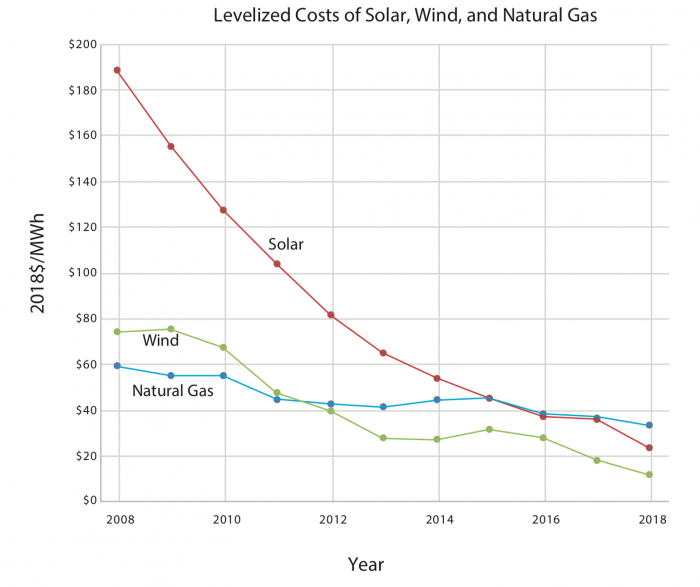The Best Reason for Optimism About Climate Action
As the saying goes, “It’s the economy, stupid.”
In 2010, a major climate change law passed by the House died in the Senate, but 12 years later, a major climate law passed both Houses. In the meantime, there had been a revolution in energy economics. If cellphone prices had dropped as fast since 2010 as the cost of power from solar panels, you could buy a new iPhone for about thirty bucks today.
I’ll unpack the numbers, but this graph from Penn State tells the story. Even if you don’t much care for graphs, I guarantee that this one is worth a look.

As you can see from the graph, the price changes were spectacular. Here’s what my research turned up. Numbers vary a bit from source to source, depending on how just how they did the calculations. But the overall picture is consistent.
In 2010, the cost of onshore wind was almost twice that of the cheapest fossil fuel generation. By 2022, the positions were reversed: onshore wind cost half as much as the cheapest fossil fuel power. The cost of solar PV fell even more steeply. In 2010, it was seven times as expensive than fossil-fuel generation. A dozen years later, the cost of solar power had dropped by nearly 90% on a price per kilowatt basis. Solar PV became almost a third less expensive than fossil fuel generation.
The cost of electricity storage has also fallen dramatically. Like solar, battery costs have dropped plunged since 2010. In just four years (2015 through 2019), the cost of storage dropped by almost 70%. The cost per kilowatt hour of 4-hour, utility-scale lithium storage is expected to fall by about an additional third by 2030. In some places — India for one — if you combine solar with battery storage the combination is still cheaper than new coal-fired generation.
As basic economics would lead us to expect, decreasing costs have translated into greater volume. Global renewable capacity quadrupled globally from 2010 to 2019, with solar capacity rising 26-fold. In little more than a decade, U.S. wind generation tripled and solar capacity was 73 times larger. By late 2023, one out of six new cars was a hybrid, plug-in hybrid, or EV, and automakers had invested more than $210 billion in EV-related manufacturing. In the U.S., Bloomberg reported in June, some EVs are now cheaper than the average new car.
Researchers have found variations in the learning curves for various technologies, with the slowest rate of learning for production of onshore wind turbines and faster for solar panel, which had about twice the learning rate of typical technologies. Battery storage has far faster learning curve than earlier clean technologies, which augurs well for the future.
Texas provides an interesting example since it obviously has no policy interest in promoting clean energy. Yet solar capacity on its grid has grown over the past five years by a factor of fourteen, from 1.3 GW to 18.8 GW. In the first quarter of this year alone, developers added 5 GW. Phrases like “eye popping” and “jaw dropping” seem appropriate here. And this is in a state where talking about climate change in public is almost considered a form of indecent exposure. The economic advantage of renewables has gotten to the point where the Texas legislature has tried to prop up new gas-fired generation with subsidies.
The upshot is that, in about a dozen years, clean energy went from being much more expensive than fossil fuels to being cheaper in many cases. That makes a world of difference.
These cost shifts are important partly because we live in a market economy where prices matter a lot. They’re also important because they mean that the energy transition is fast shifting from an economic burden on societies to an economic benefit. That means that climate policy can get a lot stronger.
Reader Comments
3 Replies to “The Best Reason for Optimism About Climate Action”
Comments are closed.







Articles that discuss the decline in solar costs would be more informative if they also addressed the cost difference between utility scale solar and roof top solar. You might do a piece on the periodic Lazard report comparing all technologies. With rooftop costing 3-5 times more, raising awareness of the cost difference might improve the California policy debate on solar.
Dan,
Your data for wind and solar is misleading and omits the cost of subsidies. When subsidies are included then real cost of wind and solar dramatically increases. That is the reason why the cost of electricity has tripled and quadrupled throughout America.
Natural gas provides continuous base load reliable power. Solar and wind are intermittent and not reliable. It is false, incompetent, and dishonest to equate the performance of wind & solar to natural gas and then call it “levelized” (lie).
As a general rule, most of the climate data that we see today is shameless propaganda and the product of junk science.